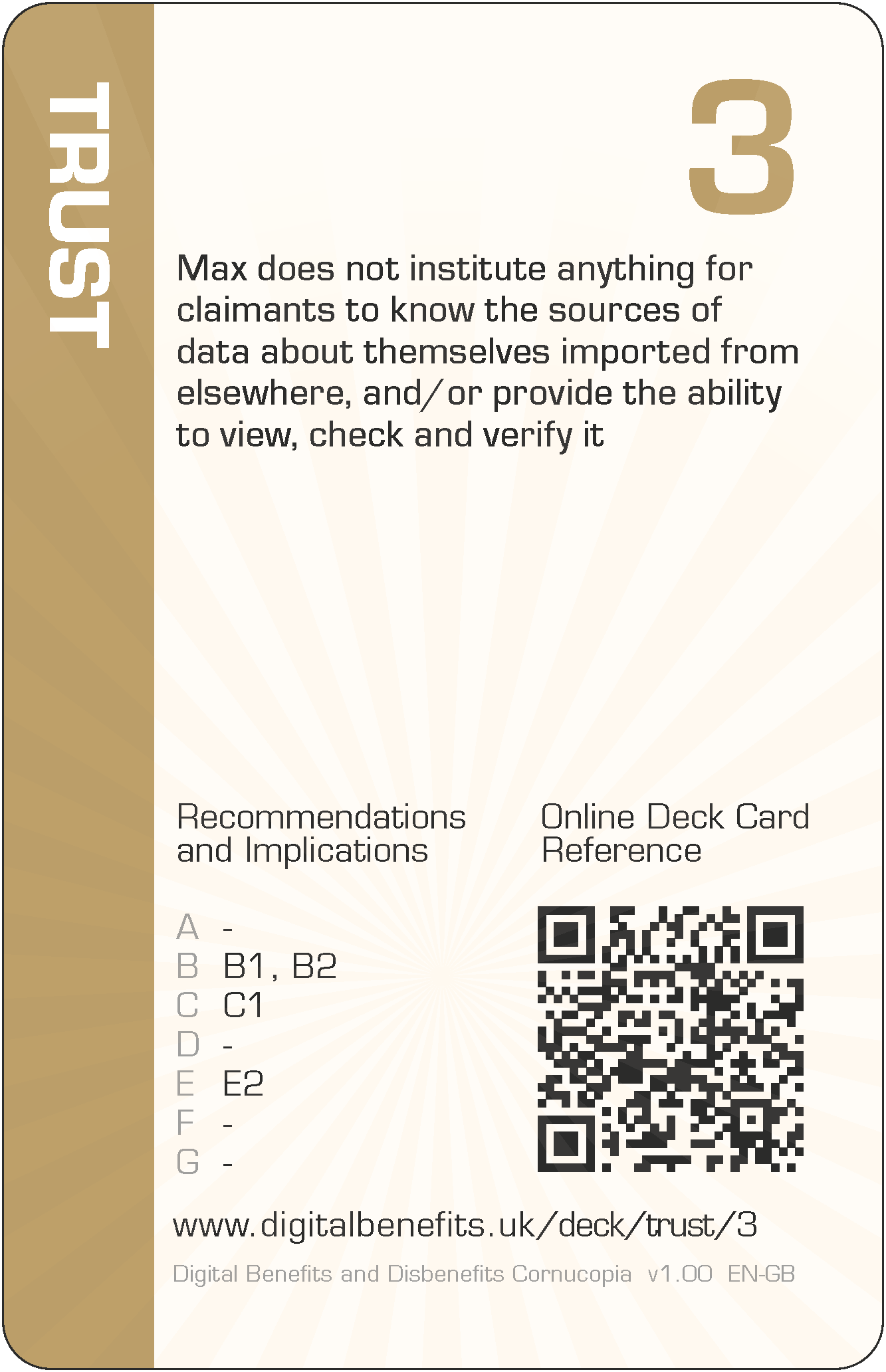Trust 3 (TR-3) Card
DBD Cornucopia > Deck > Trust > 3
Card Details - Three of Trust
Abbreviation
TR-3
Card's focus
The focus of this card is data verification
Threat to claimants
Max does not institute anything for claimants to know the sources of data about themselves imported from elsewhere, and/or provide the ability to view, check and verify it

Threat to claimants
Max does not institute anything for claimants to know the sources of data about themselves imported from elsewhere, and/or provide the ability to view, check and verify it.
Some examples of how this threat could lead to harms (negative effects on claimants)
The design recommendations and implications relevant to the card are listed below in the next section, but even those can be somewhat abstract and difficult to think about during practical day-to-day implementation. Therefore, some example harms are provided to complement the more formal research outputs. These examples are unique per card, and are only published on these web pages (i.e. in no other project outputs).
- Claimants are none the wiser that employers make mistakes in payroll data which affect claims, incorrectly reducing award payments, which only become clear on the payment date
- Wrong information is used to assess claims, but claimants cannot see the data and so are unable to proactively warn about the problem, leading to more reported 'fraud and error' which adds to stigmatisation of all claimants and deductions from individuals' payments
The examples are to help understand the threat on the card, not to suppress thinking and innovation. Incorporating these examples exactly, or closely matching ones, should be scored down when playing DBD Cornucopia as a game.
Applicable design recommendations and implications
These are reproduced here from Research Briefing N
Acknowledge claimants as people in digital design
- Prioritise claimants' interests over system efficiencies
All digital welfare design processes, methods and decision-making should prioritise claimants' needs to achieve best outcomes for individuals rather than system efficiencies. Organisational knowledge and resources should be utilised to this respect including intervening in advance to identify matters that affect claims or what claimants may have forgotten about. - Ensure system and state accountability to claimants
Equalise accountability between claimants and the state. Promote a sense of fairness by enforcing an expectation that service level standards for actions and response times should be similar to those expected of claimants, with related penalties not disproportionately, or only, affecting claimants. Provide tools/methods for claimants to easily check, query and challenge actions and decisions.
Reduce claimants’ interaction burdens with digital welfare
- Shift the burden of gathering evidence from claimants towards the state
Transfer effort from claimants to the state, to improve timeliness and reliability. Prioritise the implementation of dig- ital processes to gather or import, check and use necessary data from internal and external providers. Change claimants' role to verifying the data, rather than providing it, and ensure claimants have visibility and control over derived status attributes.
Design systems which support the division of labour with claimants' ecosystems
- Expand claimant autonomy, control and choice, backed up by transparency of actions and activities
Enable claimants to better engage with digital welfare and empower them to make their own choices and decisions. Attribute information sources, other advice and decisions; build in logging and audit trail generation; provide access to records of what information was used to make choices/decisions and by whom; provide mechanisms for claimants to question, discuss and challenge actions, provide feedback, and make complaints.
General Notes
Card values (i.e. '3' for this card) are for game play and are not correlated with the severity of harm. This is because threats cannot be ranked directly since they can affect individuals in different ways due to situations and circumstances, or affect fewer or more claimants, or the harms can arise in claimants' support networks and wider society.
The threat description uses a person's name as the "attacker" (i.e. 'Max' for this card), which can be thought of someone involved with implementation. They could have any role which influence digitisation. So they could be a database administrator, or a copy writer, or a quality assurance specialist, etc, or all of these. Everyone could have some influence on the claimant threat described. The names were randomly selected from those currently most popular as given names for boys and girls (UK Office for National Statistics).
The example harms provided are drawn from the research data (which explored not only parts of existing services but also the effects of possible changes to those), from the author's own knowledge of web application development and testing, the author's own experience of helping citizens to claim Universal Credit (UC) and Personal Independence Payment (PIP), and from suggestions submitted by other people (make a suggestion). The threats and example harms do not necessarily exist in the current UC or PIP deployments or in ecosystems around those services, but they might well do.
All the cards in this Trust suit are: 2 3 4 5 6 7 8 9 10 J Q K A
The other suits in the deck are: Scope, Architecture, Agency, Porosity and Cornucopia (plus Jokers).
